The Intel Broadwell Xeon E3 v4 Review: 95W, 65W and 35W with eDRAM
by Ian Cutress on August 26, 2015 9:00 AM ESTOffice Performance
Dolphin Benchmark: link
Many emulators are often bound by single thread CPU performance, and general reports tended to suggest that Haswell provided a significant boost to emulator performance. This benchmark runs a Wii program that raytraces a complex 3D scene inside the Dolphin Wii emulator. Performance on this benchmark is a good proxy of the speed of Dolphin CPU emulation, which is an intensive single core task using most aspects of a CPU. Results are given in minutes, where the Wii itself scores 17.53 minutes.

Dolphin prefers single threaded speed and IPC, which the extra frequency of the v3 wins out here. The disparity between the 65W/95W v4 processors and the 35W processor is most obvious here.
WinRAR 5.0.1: link
Our WinRAR test from 2013 is updated to the latest version of WinRAR at the start of 2014. We compress a set of 2867 files across 320 folders totaling 1.52 GB in size – 95% of these files are small typical website files, and the rest (90% of the size) are small 30 second 720p videos.
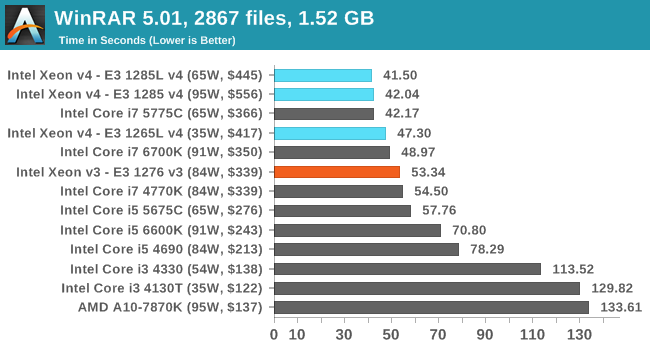
WinRAR is our classic 'eDRAM works here!' benchmark, clearly showing how Broadwell benefits. Although, one might argue that WinRAR is not a typical workload environment. It is also poignant to show that the 95W v4 doesn't win here in this variable-threaded load.
3D Particle Movement
3DPM is a self-penned benchmark, taking basic 3D movement algorithms used in Brownian Motion simulations and testing them for speed. High floating point performance, MHz and IPC wins in the single thread version, whereas the multithread version has to handle the threads and loves more cores.
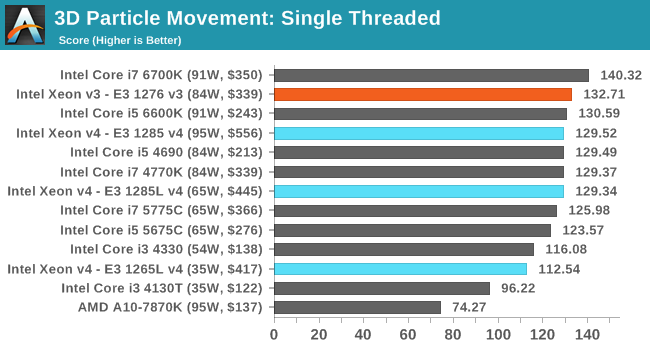

Similar to CineBench, in single threaded mode the v3 wins out due to the faster frequency, but in multithreaded mode the advancements in the Broadwell core due to better thread resource management puts at least the 95W v4 ahead.
FastStone Image Viewer 4.9
FastStone is the program I use to perform quick or bulk actions on images, such as resizing, adjusting for color and cropping. In our test we take a series of 170 images in various sizes and formats and convert them all into 640x480 .gif files, maintaining the aspect ratio. FastStone does not use multithreading for this test, and results are given in seconds.
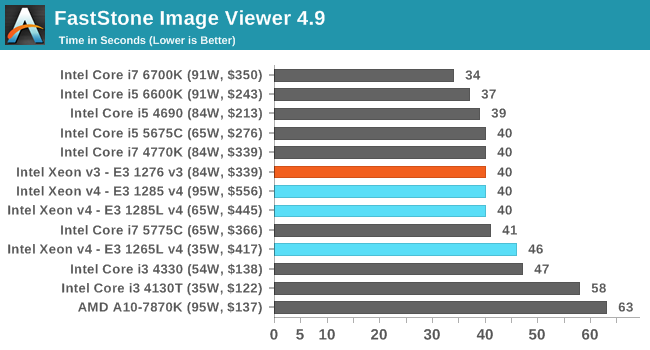
Web Benchmarks
On the lower end processors, general usability is a big factor of experience, especially as we move into the HTML5 era of web browsing. For our web benchmarks, we take four well known tests with Chrome 35 as a consistent browser.
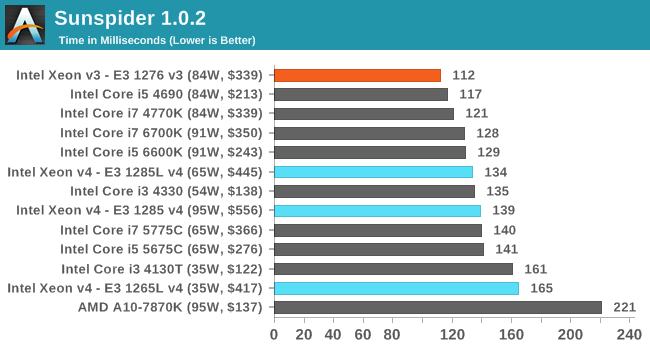
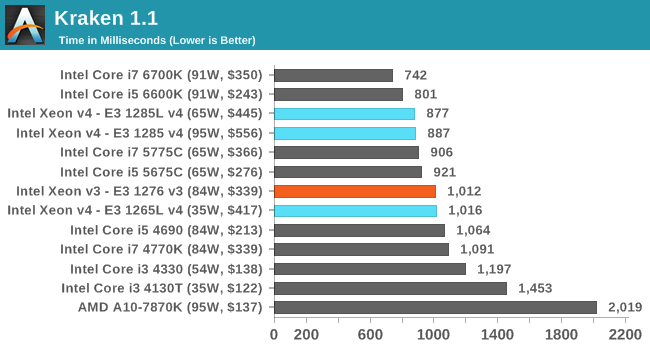


For web implementations, both Kraken and Octane see benefits moving up to Broadwell, but it is worth noting that moving to Skylake is an even better benefit. This again comes down to the management of CPU instructions between threads, and having benefits associated with keeping the knowledge of past instructions or information in lower cache levels. In would seem in this regard, if you count these benchmarks indicative of a real workload, that web-based throughput implementations are more in-flight operation limited than any other resource.










72 Comments
View All Comments
lilmoe - Wednesday, August 26, 2015 - link
+1I'm looking forward to the new mobile Xeon chips and would love to see that too.
Ian Cutress - Thursday, August 27, 2015 - link
Working on it! :)satai - Friday, August 28, 2015 - link
Great to hear that.Atari2600 - Wednesday, August 26, 2015 - link
Ian,Primarily in the graphs you compare a 1276 v3 to two flavours of 1285 v4.
But, on the first page, you tabulate the 1285 v3 and 1265 v3.
Would it be possible to include the 1276 v3 in this table?
Just quickly looking at ark.intel; the 1276 v3 has a box price of $350 and seems otherwise identical to the 1285 v3. On the face of it, it appears a disruptor.
Cheers
Brendan
lilmoe - Wednesday, August 26, 2015 - link
That's one hell of a 35W chip. Not bad at all.jamyryals - Wednesday, August 26, 2015 - link
Why does the 95Watt part exist? I don't get it.Gigaplex - Wednesday, August 26, 2015 - link
And why does the 65W chip consume more power than the 95W one?Oxford Guy - Wednesday, August 26, 2015 - link
Because Intel's power consumption ratings are a load of nonsense often enough. And AMD isn't always accurate either. The 8320E, for instance, is rated 95W but actually used 86 in Anandtech's tests. The 8370E is rated 95W but used 107 or something. The 9590 is even further away from its rating.But, Intel is the one gaining the most from this deceptive marketing since people know AMD's FX chips are power-hungry due to being on 32nm and not having had as much money invested in hand-tuning to lower power. So, Intel underestimates the consumption of parts like the 4790K to make its chips seem even more dramatically efficient.
Yuriman - Thursday, August 27, 2015 - link
There's one problem with this: TDP is not "power consumption", but "Thermal Design Power". A chip with a 95w TDP needs to function in an environment designed to dissipate 95w of heat over a given period of time. CPUs can go well over this for short periods.Oxford Guy - Thursday, August 27, 2015 - link
Short periods are one thing. False advertising is another.